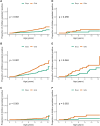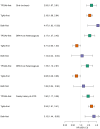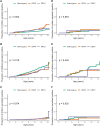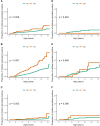Early Appearance of Thyroid Autoimmunity in Children Followed From Birth for Type 1 Diabetes Risk
- PMID: 38996042
- PMCID: PMC11747670
- DOI: 10.1210/clinem/dgae478
Early Appearance of Thyroid Autoimmunity in Children Followed From Birth for Type 1 Diabetes Risk
Abstract
Context: Autoantibodies to thyroid peroxidase (TPOAb) and thyroglobulin (TgAb) define preclinical autoimmune thyroid disease (AITD), which can progress to either clinical hypothyroidism or hyperthyroidism.
Objective: We determined the age at seroconversion in children genetically at risk for type 1 diabetes.
Methods: TPOAb and TgAb seropositivity were determined in 5066 healthy children with human leukocyte antigen (HLA) DR3- or DR4-containing haplogenotypes from The Environmental Determinants of Diabetes in the Young (TEDDY) study. Children seropositive on the cross-sectional initial screen at age 8 to 13 years had longitudinally collected samples (from age 3.5 months) screened retrospectively and prospectively for thyroid autoantibodies to identify age at seroconversion. The first-appearing autoantibody was related to sex, HLA genotype, family history of AITD, and subsequent thyroid dysfunction and disease.
Results: The youngest appearance of TPOAb and TgAb was age 10 and 15 months, respectively. Girls had higher incidence rates of both autoantibodies. Family history of AITD was associated with a higher risk of TPOAb hazard ratio (HR) 1.90; 95% CI, 1.17-3.08; and TgAb HR 2.55; 95% CI, 1.91-3.41. The risk of progressing to hypothyroidism or hyperthyroidism was not different between TgAb and TPOAb, but children with both autoantibodies appearing at the same visit had a higher risk compared to TPOAb appearing first (HR 6.34; 95% CI, 2.72-14.76).
Conclusion: Thyroid autoantibodies may appear during the first years of life, especially in girls, and in children with a family history of AITD. Simultaneous appearance of both autoantibodies increases the risk for hypothyroidism or hyperthyroidism.
Keywords: autoimmune thyroid disease; children; thyroid autoimmunity.
© The Author(s) 2024. Published by Oxford University Press on behalf of the Endocrine Society.
Figures






References
-
- Pearce EN, Farwell AP, Braverman LE. Thyroiditis. N Engl J Med. 2003;348(26):2646‐2655. - PubMed
-
- Vanderpump MPJ, Tunbridge WMG, French JM, et al. The incidence of thyroid disorders in the community: a twenty-year follow-up of the Whickham Survey. Clin Endocrinol (Oxf). 1995;43(1):55‐68. - PubMed
-
- Antonelli A, Ferrari SM, Corrado A, Di Domenicantonio A, Fallahi P. Autoimmune thyroid disorders. Autoimmun Rev. 2015;14(2):174‐180. - PubMed
-
- Rotondi M, de Martinis L, Coperchini F, et al. Serum negative autoimmune thyroiditis displays a milder clinical picture compared with classic Hashimoto's thyroiditis. Eur J Endocrinol. 2014;171(1):31‐36. - PubMed
-
- Katsarou A, Gudbjornsdottir S, Rawshani A, et al. Type 1 diabetes mellitus. Nat Rev Dis Primers. 2017;3(1):17016. - PubMed
MeSH terms
Substances
Grants and funding
- UL1 TR000064/TR/NCATS NIH HHS/United States
- UL1 TR002535/TR/NCATS NIH HHS/United States
- UC4 DK112243/DK/NIDDK NIH HHS/United States
- U01 DK124166/DK/NIDDK NIH HHS/United States
- U01 DK063790/DK/NIDDK NIH HHS/United States
- National Institute of Allergy and Infectious Diseases
- UC4 DK095300/DK/NIDDK NIH HHS/United States
- ES/NIEHS NIH HHS/United States
- UC4 DK117483/DK/NIDDK NIH HHS/United States
- Eunice Kennedy Shriver National Institute of Child Health and Human Development
- UC4 DK106955/DK/NIDDK NIH HHS/United States
- UC4 DK100238/DK/NIDDK NIH HHS/United States
- P30 DK017047/DK/NIDDK NIH HHS/United States
- CC/CDC HHS/United States
LinkOut - more resources
Full Text Sources
Medical
Research Materials

